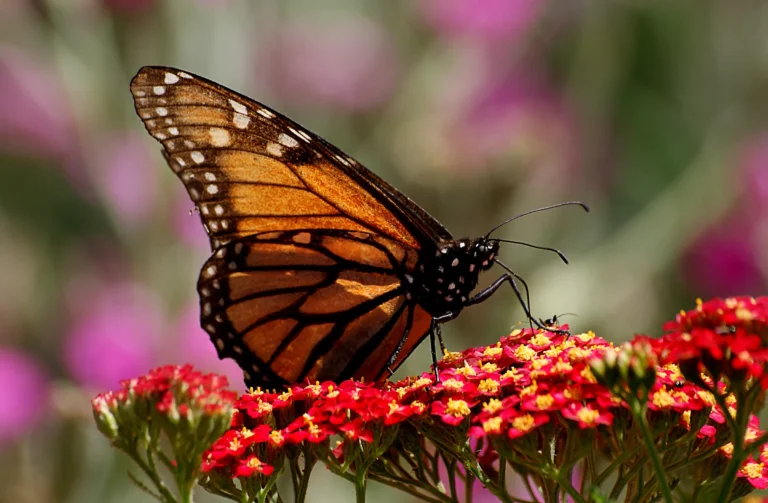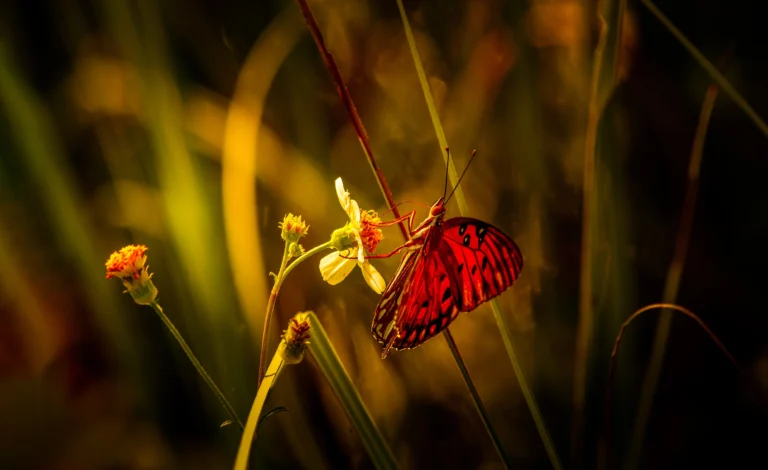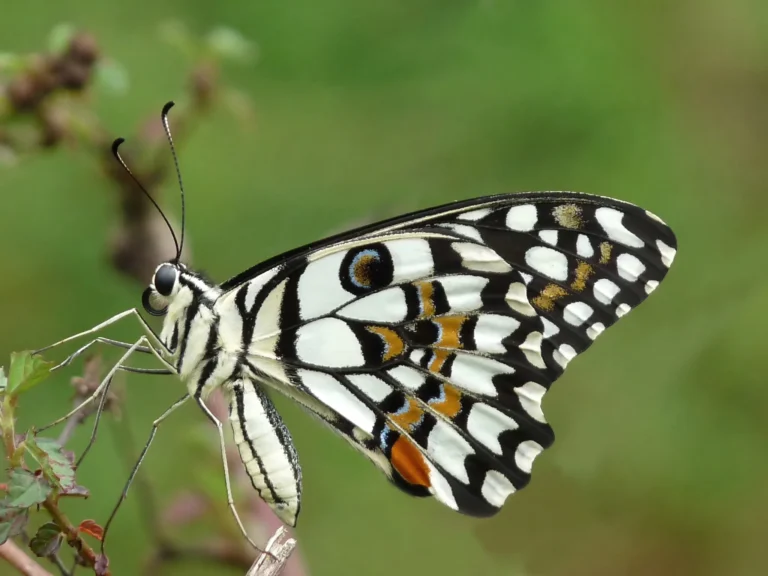Papilio Maackii: Alpine Black Swallowtail Butterfly: Lifecycle, Habitats, Facts & More
Quick Summary: The Alpine Black Swallowtail, known scientifically as Papilio maackii, is a beautiful butterfly found mainly in East Asia. With a distinctive black and blue appearance, it’s unique from other swallowtails. Its life begins as an egg, then transforms through caterpillar and chrysalis stages to become an adult butterfly.
These butterflies feed on citrus plants as caterpillars and nectar as adults. They have roles in pollination and also feature in cultural stories. In gardens, they can be both a delight for their beauty and sometimes a concern for citrus growers. Their behavior varies with seasons, often hibernating in cold months and being most active in summer.
Table of Contents
Introduction
Welcome to the fascinating world of butterflies, where one species stands out for its unique charm and significance: the Papilio maackii. Also known as the Alpine Black Swallowtail, this butterfly is not just another beautiful insect fluttering around in our gardens; it holds a special place in the field of entomology.
But why is the Papilio maackii so essential? In the vast world of swallowtail species, This beautiful creature sets itself apart with its distinct markings and behavior.
While many swallowtails dance in the skies, the Papilio maackii tells its own story, inviting observers to delve deeper into its captivating life cycle and habitat.
This article will explore every nook and cranny of this remarkable species, showcasing its uniqueness and the role it plays in our ecosystem.

Classification & Distribution
When it comes to understanding the Papilio maackii, it’s vital to know where it stands in the vast web of life. Let’s dive into its scientific classification:
- Kingdom: Animalia
- Phylum: Arthropoda
- Class: Insecta
- Order: Lepidoptera
- Family: Papilionidae
- Genus: Papilio
- Species: P. maackii
Now, knowing its classification, where can you spot this unique butterfly? The Alpine Black Swallowtail is predominantly found in regions spanning Eastern Asia. These regions include parts of China, Korea, Japan, and even the Russian Far East.
The habitats that the butterfly prefers are typically forested areas, especially those located in mountainous terrains. These green, elevated landscapes offer the butterfly ample resources and protection, making them ideal spots for their lifecycle to unfold.
Interested in butterflies of different regions? Explore the butterflies of Italy.
Physical Characteristics
The Papilio maackii butterfly mostly stands out because of how it looks.
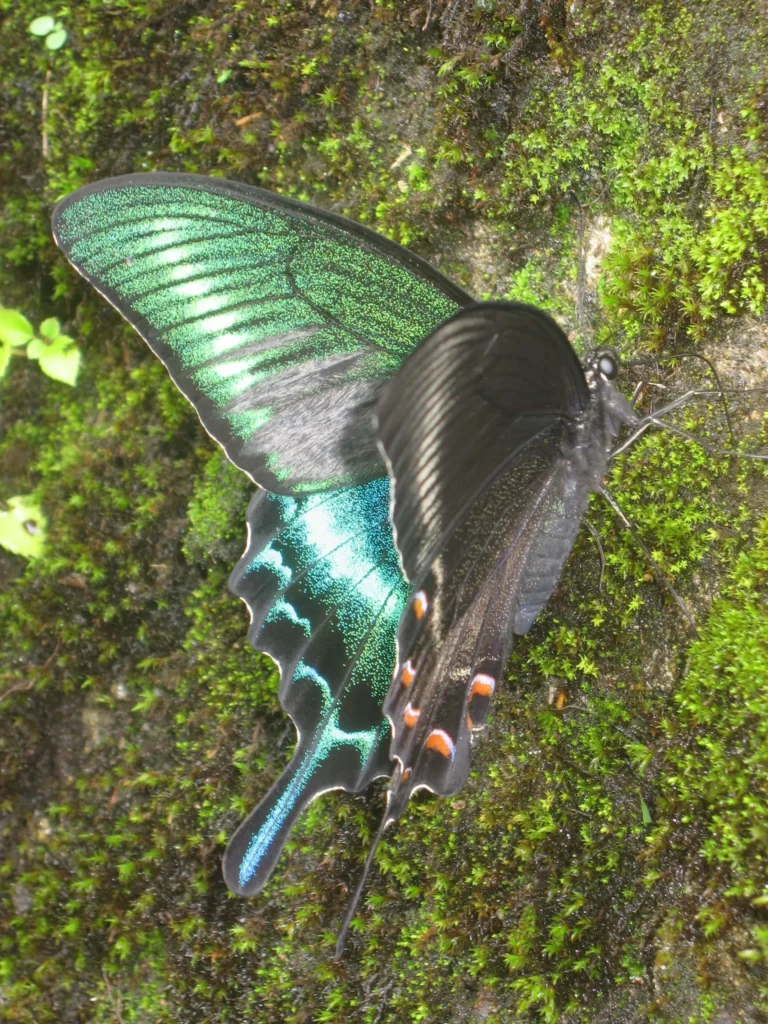
Appearance
When you see this butterfly, the first thing you’ll notice is its wings. They are mostly black. But the black color isn’t plain. It has bright spots of blue and green that shine in different ways when the light hits them.
Distinctive Markings and Wing Patterns
This butterfly has more than just its bright spots. If you look at the edges of its back wings, you’ll see small red or orange dots. These dots add a nice touch to the butterfly’s look.
Some of these butterflies also have a blue line on their wings, which looks great against the black color. And, like other swallowtails, they have ‘tails’ on the ends of their back wings.
Size Comparison
In terms of size, the Papilio maackii stands fairly large among its butterfly peers. On average, its wingspan can range from 60 to 80 mm, making it notably larger than many other swallowtail species.
When you spot a butterfly of such grandeur in the forests of East Asia, there’s a high chance it could be the Papilio maackii.
Learn more about butterfly features with our article on butterfly antenna.
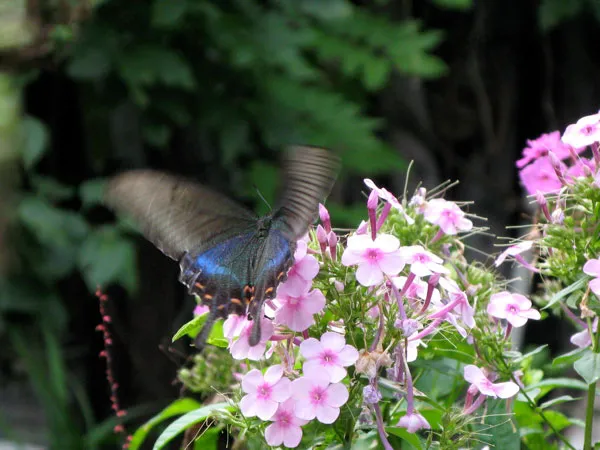
Life Cycle and Development
The life of the Papilio maackii is a journey with four main steps: the egg, larva (caterpillar), pupa (chrysalis), and the adult butterfly. Let’s explore each phase in detail.
Egg
The starting point of this butterfly’s life is the tiny egg. These eggs are round and very small, usually a pale yellow color. Female butterflies choose to lay their eggs on plants that will be good food for the caterpillars when they hatch. The egg stage lasts for a few days before the next stage begins.
Larva (Caterpillar)
After hatching, the tiny caterpillar comes out. This caterpillar is green with black and white patterns, making it blend well with the leaves it feeds on.
The young caterpillar is very hungry and eats a lot. It mostly likes citrus plants and some other leafy plants. As it eats, it grows bigger and goes through several stages, shedding its skin each time.
Pupa (Chrysalis)
Once the caterpillar is big enough, it stops eating and finds a safe place to turn into a pupa or chrysalis. This stage looks like a rest, but inside, a big change is happening.
The chrysalis is usually green or brown and hangs from branches or stems. This transformation stage lasts for about two weeks.
Adult
After the magic inside the chrysalis, the adult butterfly emerges. This fully-grown Alpine Black Swallowtail lives for a few weeks. In this time, it looks for a mate and lays eggs, continuing the cycle. The adult butterfly drinks nectar from flowers and flies around, living its short yet vibrant life.
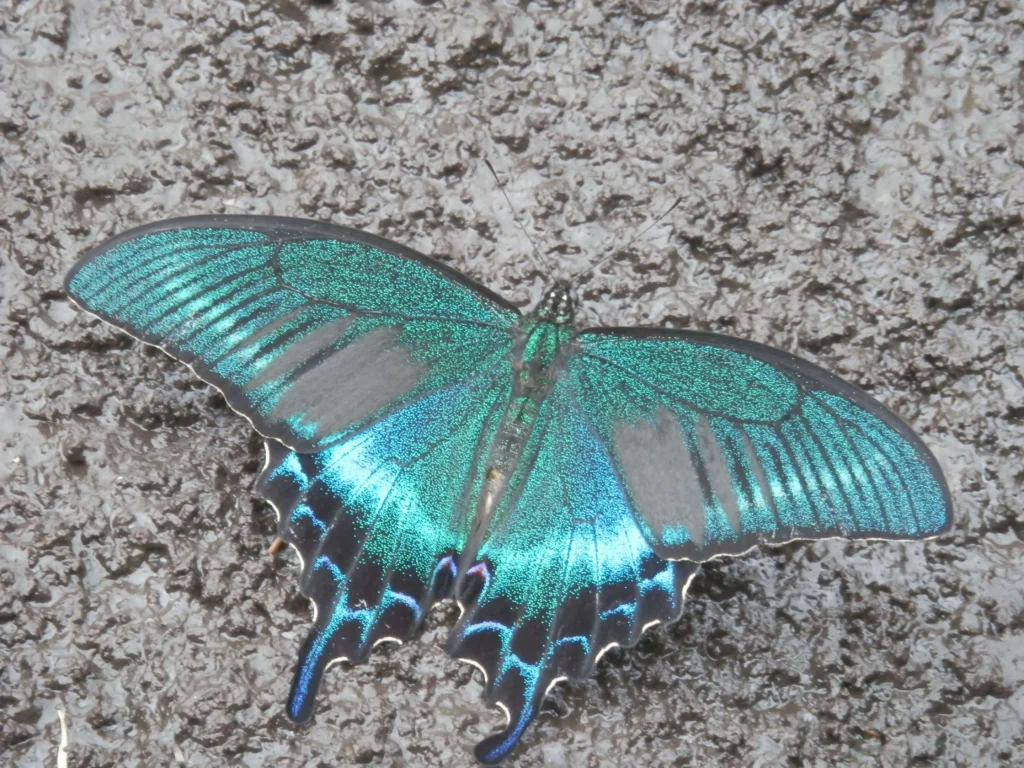
The life of the Papilio maackii is a series of exciting changes. From a tiny egg to a beautiful butterfly, each stage has its own charm and purpose. It’s amazing to see how nature has planned each step for the butterfly to grow, change, and live.
Diet and Feeding Habits
Every creature has its favorite foods, and the Papilio maackii is no different. Understanding its diet is key to understanding its role in nature.
Preferred Plants and Flowers
As young caterpillars, they have a particular taste for certain plants. Mostly, they feed on the leaves of citrus plants, like lemon and orange trees. This provides them with all the nutrients they need to grow strong and prepare for the next phase of their life.
Adult Nectar Sources
When they become butterflies, their diet changes. Instead of munching on leaves, they start sipping nectar. They flutter from flower to flower, drawing nectar from a variety of sources. Flowers like lantana, marigold, and daisy are among their favorites.
Role in Pollination
While they’re busy sipping nectar, they also play a part in helping plants. As they move from one flower to another, they carry pollen on their legs and bodies. This helps flowers produce seeds. So, even without trying, these butterflies help in the pollination process.
Learn more about this process with our article on what monarch butterflies eat.
Common Predators and Defense Tactics

In the lush green habitats of the Alpine Black Swallowtail, survival isn’t just about finding food, it’s also about not becoming food. Let’s explore the predators this butterfly faces and how it manages to outsmart them.
Common Predators in its Habitat
- Birds: Many birds have sharp eyes and quick reflexes, making butterflies like the Papilio maackii an easy target. Species such as robins, sparrows, and even some larger birds will often snatch up butterflies as a quick snack.
- Spiders: Web-building spiders create intricate traps that can easily ensnare the Papilio maackii, especially when they’re resting or flying close to vegetation.
- Praying Mantises: These insects are skilled hunters, using their long arms to grasp unsuspecting butterflies that venture too close.
- Wasps and Hornets: Some wasps and hornets hunt caterpillars to feed on their larvae, making the young stages of the swallowtail vulnerable.
Defensive Tactics Used
- Camouflaging: The caterpillar stage of the Papilio maackii is green, resembling the leaves it feeds upon. This makes it harder for predators to spot them.
- Mimicking: Some Alpine Black Swallowtails, depending on their region and the plants they’ve consumed, might develop colors and patterns that mimic other more toxic butterflies. This is nature’s way of saying, “I might be bad for your health!”
- Releasing a Bad Smell: When threatened, the caterpillars can release a bad-smelling odor from a special gland behind their head. This odor can deter predators, making them think twice before making a meal of the caterpillar.
Role of the Swallowtail ‘Tail’ in its Defense

The ‘tails’ on the wings of the Alpine Black Swallowtail are not just for show. These slender extensions are a clever defense tool.
When a predator, especially a bird, tries to catch the butterfly, they might grab onto the ‘tail’ instead of the butterfly’s body.
The butterfly can then escape, losing only a part of its wing but saving its life. It’s a smart move, giving them a chance to fly another day.
Did you know some butterflies have a defense mechanism? Learn if monarch butterflies are poisonous
Migration and Seasonal Behavior of Papilio Maackii
The journey of the Papilio Maackii isn’t just restricted to its growth from an egg to a butterfly. Like many creatures, it has adapted to the changing seasons and weather conditions in its habitat. Here’s a look at how it responds to different times of the year and the conditions nature throws at it.
Patterns Observed During Different Seasons
Spring
As the cold retreats and plants start to bloom again, adult Papilio maackii emerge from their winter hideouts, ready to mate and lay eggs. This is a busy time for the butterfly, with flowers in plenty and nectar abundant.
Summer
With warmer temperatures, the butterfly’s activity peaks. Caterpillars hatched in spring would now be on their way to becoming adults. There’s a burst of population during this time. However, with heat also comes the challenge of staying hydrated and finding shade during the hottest parts of the day.
Autumn
As the days grow shorter and temperatures begin to drop, the Alpine Black Swallowtail prepares for the colder months. Butterflies lay eggs that will overwinter, ensuring the next generation emerges with the spring warmth.
Winter
In the colder regions of its habitat, the Alpine Black Swallowtail goes into a sort of hibernation called diapause, especially in its pupal form. This dormancy helps them survive the cold, only to emerge when the conditions are favorable again.
Did you know monarch butterflies migrate by taking incredible journeys spanning thousands of miles during their migration season?
Impact of Weather Conditions on Their Behavior

Temperature
The Alpine Black Swallowtail is highly sensitive to temperature changes. Warm weather encourages flight and mating activities. However, extreme heat can be dangerous, leading the butterfly to seek cooler spots or shade.
Rain
Wet conditions aren’t ideal for flying. When it rains, these butterflies often take cover under large leaves or in dense vegetation. Prolonged rainy conditions can also impact the availability of nectar.
Wind
Strong winds can make flying challenging for the Papilio maackii. In windy conditions, they often stay closer to the ground or find sheltered spots.
Relation to Human Activities
Humans and butterflies have shared spaces for centuries, often with the butterfly taking on unique roles in our societies and cultures. The Alpine Black Swallowtail, with its striking appearance, has not been exempt from this intertwining relationship.
Let’s dig into how this butterfly has been perceived and used by humans.
Historical Significance in Cultural Contexts
Symbolism
Throughout East Asia, where the Papilio maackii is found, butterflies often symbolize transformation and rebirth due to their life cycle. Specific to the Papilio maackii, its striking colors have made it a symbol of beauty and delicacy in some cultural tales and legends.
Art and Literature
Butterflies, including the Alpine Black Swallowtail, have been depicted in traditional paintings, representing the fleeting nature of life or the beauty of nature. Some poems and songs also reference butterflies to depict themes of change, love, or loss.

Its Role in Gardening: As Pest or Beneficial Insect
Pest
The larvae or caterpillars of this insect feed on citrus plants. In areas with citrus cultivation, they can be seen as pests if their population surges, as they might defoliate young plants.
Beneficial Insect
However, in many gardens, having these butterflies is considered a boon. The adults are pollinators, which help plants reproduce. Plus, their vibrant presence adds beauty to any garden.
Interesting Facts and Trivia
There’s always something fascinating to learn about creatures in the wild. From quirky behaviors to tales spun around it, let’s dive into some lesser-known snippets about this butterfly.
Unique Behaviors or Habits Not Commonly Known
- Sunbathing Habits: Like many butterflies, Papilio maackii often spreads its wings wide to bask in the sun. This isn’t just for enjoyment; they are ectothermic, which means they rely on external sources, like sunlight, to warm their bodies and get energized for flight.
- Puddle Parties: Male Alpine Black Swallowtails have been observed gathering around puddles or damp areas, This behavior is known as ‘puddling’. They sip up the mineral-rich water, which aids in reproduction.
- Tail Wiggle: When disturbed or threatened, especially in its caterpillar form, the butterfly can evert an organ called the osmeterium. This forked, tongue-like structure releases a foul smell, which is a defense mechanism. An added touch? The caterpillar might wiggle this organ to further ward off potential threats.
Role in Myths or Folklore
- Soul Symbolism: In some East Asian cultures, butterflies represent souls, either of the living dreaming or of the departed. The Alpine Black Swallowtail, with its dark hues, might be considered a messenger between the living and the spiritual realm in some folklore.
- Transformation Tales: Given their life cycle, many tales around the world use butterflies as symbols of transformation and change. Specific tales might not mention this bug by name, but its presence in regions with rich folklore suggests it might have fluttered through a few legends.
Final Thoughts
As we come to the end of our journey exploring the Papilio maackii, it’s clear that this butterfly is truly special in nature. With its delicate wings and pretty patterns, it shows us how beautiful and resilient nature can be.
This butterfly goes through amazing changes in its life, like a magical transformation. It also helps plants grow by carrying pollen as it sips nectar from flowers. People in different cultures have even told stories about it.
But the most wonderful thing about this butterfly is seeing it in real life. If you’re lucky enough to have these butterflies where you live, take a moment to watch them flutter around flowers. It’s calming and teaches us about the balance in nature.
In our busy lives, we often forget to stop and appreciate the small wonders around us. Let the Papilio maackii remind you to pause, look around, and enjoy the beauty of the natural world. Watching a butterfly dance is like finding a story, a lesson, and a world of beauty all in one.


